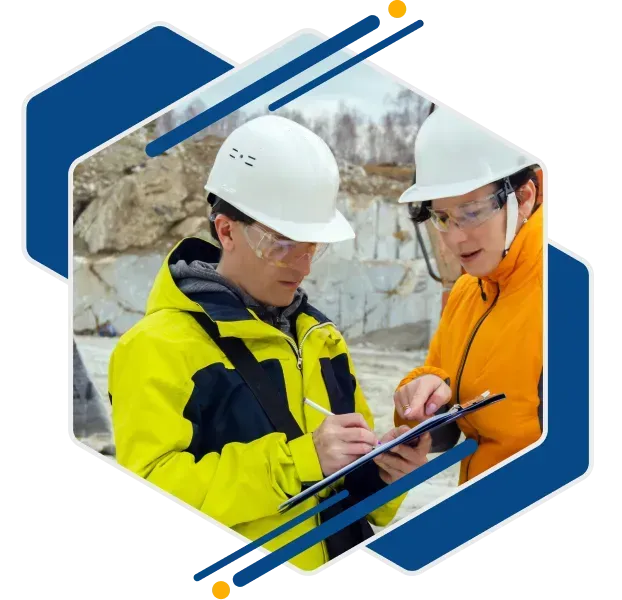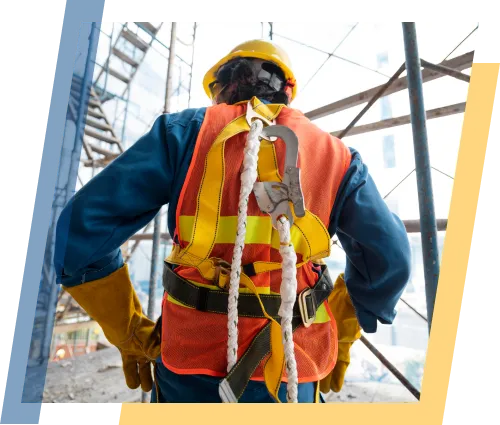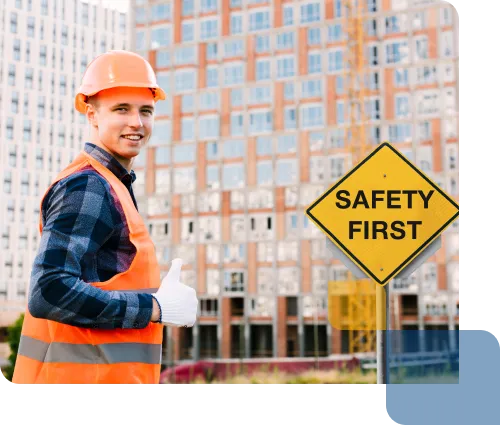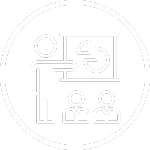Now Offering Spanish Safety Training!

Now Offering Spanish Safety Training!
Construction Safety
Safety & Health Training
FSDAVCFEBFEVSDDVFSD
FSDAVCFEBFEVSDDVFSD
FSDAVCFEBFEVSDDVFSD
Construction Safety - Safety & Health Training
Promoting a Safer Workforce On-Site at Every Project

Safety and health training equips construction workers to recognize job-specific risks, from handling equipment safely to responding effectively in emergencies. This training emphasizes compliance with OSHA regulations, aiming to reduce accidents, improve safety measures, and enhance overall site safety awareness among all employees.
Programs are tailored to address unique construction challenges such as scaffolding, electrical safety, fall protection, and hazardous material handling. Sessions are updated regularly to align with changing regulations, keeping workers informed and prepared for evolving site conditions. Effective training fosters a safer work environment by reinforcing risk awareness, building employee confidence, and supporting continuous compliance efforts.

Starting a Strong Safety Culture On Construction Sites
Developing a strong safety culture requires continuous, hands-on training tailored to construction environments. Workers must be equipped with the knowledge to identify hazards, properly use equipment, and understand safety protocols. Regular safety meetings and drills reinforce essential skills, making compliance with OSHA standards a natural part of daily operations.
Incorporating on-site safety inspections into training helps ensure practical understanding of safety measures. Inspectors can provide immediate feedback, highlighting areas that need improvement. This approach enables workers to apply training in real-world scenarios, improving both awareness and adherence to safety guidelines. Active involvement of safety officers also fosters accountability among employees.
Training sessions should also promote open communication, encouraging workers to voice concerns, ask questions, and suggest improvements. Creating an environment where feedback is valued not only strengthens team collaboration but also keeps safety protocols relevant and effective. This shared responsibility for safety builds a proactive mindset, reducing risks and promoting a safer workplace overall.
Addressing Risks Through Industry-Specific Training

Training programs should address industry specific risks often encountered on construction sites. Courses must cover crucial topics like fall prevention, heavy equipment handling, and hazardous material management. For instance, utilizing industrial hygiene sampling for training purposes can help workers better understand air quality hazards and exposure limits. This targeted approach ensures that workers are equipped with skills to manage their unique site conditions confidently.
Feedback plays a significant role in refining training efforts. Regular assessments and worker surveys can highlight gaps in knowledge, allowing for timely updates to training materials. This adaptive strategy keeps the content relevant and effective. Additionally, training should incorporate real-life scenarios, which make it more engaging and memorable for participants. This hands-on methodology reinforces skills, reduces risks, and supports complete OSHA compliance.

Continuous learning is vital to maintaining safety standards in construction. Ongoing workshops and refresher courses ensure workers stay informed about new safety regulations, procedures, and best practices. For instance, scheduling OSHA compliance assessments identifies gaps in current practices and ensures that training materials are updated to match evolving safety requirements. This proactive approach keeps workers prepared to manage emerging risks, ultimately reducing on-site incidents and fostering a safer work culture.
Collaboration between workers and safety trainers plays a significant role in effective learning. Facilitators should encourage workers to share their insights and provide feedback during training sessions. This open dialogue helps refine safety measures, making them more practical and relevant to real-world situations. As employees contribute to training development, they become more engaged and invested in maintaining safety standards, resulting in a more compliant workplace.
Frequently Asked Questions
Frequently Asked Questions
What types of Safety & Health Training does Nain and Associates offer for the construction industry?
Nain and Associates provides a broad range of training programs specifically designed for construction workers, including fall prevention, scaffolding safety, electrical hazards, and the correct use of personal protective equipment. Our sessions are led by experts and tailored to meet the unique safety challenges of construction sites.
How does Safety & Health Training by Nain and Associates differ from other training programs?
Our training programs are distinguished by their customization to the specific needs of your construction projects, hands-on learning experiences, and integration of real-world scenarios. This approach not only ensures compliance with OSHA standards but also enhances the practical safety skills of your workforce, fostering a proactive safety culture.
Can Nain and Associates provide training directly on our construction sites?
Yes, Nain and Associates specializes in delivering on-site safety orientations and training sessions directly at your construction sites. This ensures that the training is relevant and directly applicable to your team's daily tasks and the specific hazards they face.
What benefits can my construction company expect from investing in Safety & Health Training with Nain and Associates?
Investing in our Safety & Health Training can lead to a significant reduction in accidents and injuries, ensuring compliance with OSHA regulations, improving project efficiency, and fostering a strong culture of safety within your team. This not only protects your workforce but also enhances your company's reputation and operational success.
How do we get started with Safety & Health Training services from Nain and Associates for our construction company?
To get started, contact Nain and Associates to discuss your training needs. We will work with you to assess your specific requirements, the scope of your construction activities, and tailor a training program that aligns with your safety goals and project demands, ensuring a comprehensive and effective safety education for your workforce.
Engaging Hands-On Training Methods for Safety Success
Hands-on training methods are crucial for retaining the information. Interactive sessions like drills, role-playing scenarios, and real-life demonstrations help workers understand safety protocols better. This active learning reinforces knowledge, making safety measures easier to remember and apply.
Implementing specialized safety training within construction settings ensures that workers are prepared for industry-specific hazards. Addressing risks like chemical exposure, confined spaces, and hazardous material handling creates a safer job site. Training content should be updated regularly to align with OSHA standards, keeping employees aware of the latest safety practices.
Frequent training assessments further enhance learning outcomes. Reviewing training effectiveness through employee feedback, safety audits, and incident tracking helps identify gaps. Adjusting training materials based on these findings keeps safety initiatives relevant and effective, fostering a culture of ongoing improvement.


Regular safety communication is crucial for sustaining safety progress on construction sites. Routine meetings allow supervisors to share updates, address concerns, and reinforce protocols. Distributing clear safety materials ensures workers understand the latest regulations. Encouraging open dialogue fosters a proactive culture, where employees can share feedback and suggest improvements. This ongoing communication helps maintain compliance and reduces risks by keeping everyone informed and engaged. A collaborative approach leads to consistent adherence to safety measures, creating a safer work environment.
Fostering Proactive Safety Mindsets in Construction Workers
Creating a safety-first mindset within the workforce starts with strong, ongoing training programs. Trainers should emphasize the importance of personal responsibility, encouraging workers to understand and manage risks actively. Incorporating scenarios that mirror real job site hazards helps bridge the gap between training and practical application. This method ensures workers can handle unexpected challenges, further enhancing overall safety compliance.
Sustaining a safe work environment also relies on regular evaluations and updates to training materials. Conducting safety and health committee meetings keeps safety protocols aligned with OSHA regulations and site conditions. Trainers and safety personnel should collaborate frequently to assess the effectiveness of current safety measures and adjust them as needed. For tailored safety improvements, consider engaging on-site safety experts, who provide guidance on addressing site-specific risks and creating targeted training initiatives.
Lastly, consistent monitoring and feedback loops solidify safety as a core value. Engaging workers in the evaluation process helps identify gaps and potential areas for improvement, making safety training more relevant and effective. This approach encourages workers to take ownership of safety measures, ensuring better compliance and fewer incidents. With well-structured training programs and a commitment to continuous learning, organizations can foster a safety-oriented culture that supports long-term success.
Have Questions About Our Services?
Contact us to learn more today!
Have Questions About Our Services?
Contact us to learn more today!
Design By: Customers.Plus
© 2026 | Nain & Associates LLC




